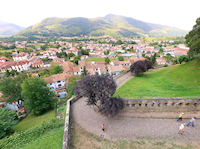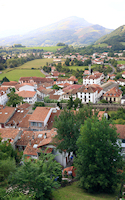

Previous page
Next page
Saturday, July 16. Visit a makhilas handicrafts factory in Larressore the morning, noon return to Espelette for lunch and the afternoon, visit of Saint-Jean-Pied-de-Port. No video for today.
First, the makhila. As I was not allowed to take pictures, I refer you to google to see what it looks like. The makhila (or makila) means ''stick'' in Basque and this is the traditional
Basque walking stick (not shepherd's crook). Walking stick yes, but also a formidable weapon of defense. The makhila consists of a steel spike of about 10cm, which is revealed by
unscrewing the knob and a ''Clover'' at the bottom of makhila and weighing its weight, it serves as a club. The makhila, as it is made by the architect of Larressore, consists of
a stick Medlar, the ferrules are metal (nickel, silver or gold) is located at each end of the stick. There is also the handle, it is sheathed with a braided leather or metal,
the strap is leather and the pommel is made of horn or metal.
Made entirely by hand, stick medlar (wild) is first worked on his foot, the craftsman cut the wood for the sap heals wounds and draw the spirals on wood, embossed and not hollow. On the shell bottom
is engraved the date of completion and the name of the craftsman. The makhila is mainly offered at special occasions or a special event because it is long and expensive to manufacture,
it is primarily an honor and very personal subject for the name, motto or symbol / emblem of the person it is offered is chiseled.
This is called a ''facade'' (and it's at Larressore) and that's when you play the pincushion Basque (also called ''tennis'' in other regions). Each city, village and hamlet in the Basque country has at least a facade. you can tell
they love their pincushion the Basque. It is a very physical sport where you need good reflexes.
After the workshop makhila we return to Espelette for ... eat. Again the Axoa for me, it's so good (I'm on the verge of drooling in writing my article, Axoa is a cheat meal because it make
us wanting to it that juste by thinking of it). With the passage a picture of a building (house?) Near the center of Espelette. We also see a house whose facades are decorated
with Espelette chili peppers being dried.
After an excellent meal (yet), we have to digest. What better way to make the 161m climb to go from bottom of Saint-Jean-Pied-de-Port to the top of the citadel? The city is an almost
obligatory for all Jacquets de France (the pilgrims of Saint Jacques de Compostela) to take the pass of Roncesvalles and then go to Compostela. There is a church of the Assumption
of the Virgin (formerly called Notre Dame du Bout du Pont), where you can relax (and in the various shelters in the village). You can also visit an exhibition on the pilgrims of Saint
Jacques de Compostela (coupled with an exhibition on the various traditionnals costumes Basque). We learn many things, among other things how to make a pilgrim's balm (which is the recipe as it
is written: tallow candle, brandy, olive oil. (I do not have measures unfortunately)).
We will then towards the citadel. On the way we see the door with the date above and some are very old.
We climb we climb, the citadel is placed decidedly good height. Built between 1625 and 1627 by Pierre de Conty de La Mothe d'Argencourt, the Nicolas Desjardins continues between 1640 and 1648.
Then, from 1686 to 1700 and until 1728, the engineer François Ferry assistant to various buildings and defenses under the instruction of Vauban (Sébastien Le Prestre, Marquis de Vauban).
The fortress now houses a school and cannot be visited. The walls above the village and its surroundings and the look is far away.


It starts to get late, we should think of returning. So we return to Guiche and make a few stops-minutes time to take some pictures, here a castle, is a panorama, a panel or a
cloud showing us the direction.


Back in Guiche, a pincushion game is being played on the front nine while. This is obviously still the party since July 14 and it is not ready to stop, the festivities will last for several days.
We'll have to sleep well for tomorrow, towards Spain.
Previous page
Next page




